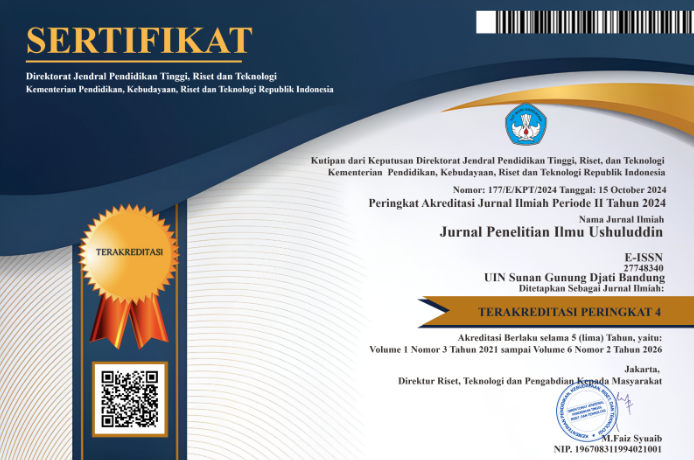Hadis-hadis tentang Pengobatan Herbal: Studi Takhrij dan Syarah Hadis dengan Tinjauan Kesehatan
DOI:
https://doi.org/10.15575/jpiu.14453Keywords:
Hadith, Health, Herbs, Takhrij, Treatment, SyarahAbstract
This study aims to discuss the hadiths regarding herbal medicine with a health review. This study applies a qualitative type through literature study using the takhrij and syarah hadith methods. The results and discussion of this study include an overview of herbal medicine, editorials of hadith on herbal medicine, understanding of hadith regarding herbal medicine, and the content and benefits of herbal medicine for health. This study concludes that the herbal treatment recommended by Rasulullah SAW. proven in modern medicine has many health benefits. This can strengthen the hadith of the Prophet Muhammad. where the hadith appeared long before the advancement of medical science and technology.
References
Ahmad, A. S. B. (2013). Keistimewaan Kurma dalam Al-Qur’an Ditinjau dari Perspektif Ilmu Kesehatan (Doctoral dissertation, Universitas Islam Negeri Sultan Syarif Kasim Riau).
Al-Asqalani, I. H. (1379). Fathul Bari Syarah Shahih Bukhari. Beirut: Dar al-Ma'rifah.
Al-Bukhari, M. b. (2009). Shahih Al-Bukhari. Lidwa Pustaka i-Software.
Al-Haq, A. A.-T. (1388). 'Aunul Ma'bud Syarah Sunan Abi Daud. Beirut: Dar al-Kotob al-Ilmiyah.
Ali, N. (2008). Hadis Versus Sains. Yogyakarta: Teras.
Al-Jauziyah, I. Q. (2020). Ath-Thibbun An-Nabawi. Yogyakarta: Diva Press.
An-Nawawi, M. Y. (1414). Al-Minhaj Syarah Shahih Muslim. Beirut: Darul Ma'rifah.
Author, R. a. (2013, April 8). Beberapa Manfaat al-Qust al-Bahri dan al-Qust al-Hindi (Costus Speciosus). Retrieved from rifqielauthor.blogspot.com: http://rifqielauthor.blogspot.com/2013/04/beberapa-manfaat-al-qust-al-bahri-dan.html?m=1
Barry Robson, O. K. (2009). The Engines of Hippocrates: From the Dawn of Medicine to Medical and Pharmaceutical Informatics. Canada: John Wiley & Sons.
Baththal, A. a.-H. (1423). Syarah Shahih al-Bukhari li Ibnu Baththal. Riyadh: Maktabah al-Rusyd.
Bharat B. Aggarwal, C. S. (2007). Curcumin: the Indian solid gold. Advances in Experimental Medicine and Biology, 1-75.
Bown, D. (1995). Encyclopedia of herbs & their uses. London: Dorling Kindersley.
Brickell, C. (2004). The Royal Horticultural Society Encyclopedia of Gardening. London: Dorling Kindersley.
Cidadapi, I. E. (2016). Ramuan Herbal Ala Thibbun Nabawi. Putra Danayu.
Dalil, F. Y. M. (2017). Hadis-Hadis tentang Farmasi; Sebuah Kajian Integratif dalam Memahami Hadis Rasulullah. Proceeding IAIN Batusangkar, 1(1), 309-326.
Darmalaksana, W. (2020, Maret 20). Panduan Praktis Menyusun Proposal Penelitian. Retrieved from https://www.yudidarma.id/2020/03/panduan-praktis-menyusun-proposal.html
Fahmi, A. (2018). Bimbingan Nabi Muhammad Saw Tentang Komposisi dan Porsi dalam Mengkonsumsi Buah Kurma. UIN Walisongo Semarang, 11.
Femina. (2016, February 18). Rempah Daun Lokal. Retrieved from Gaya Hidup Masa Kini: https://www.femina.co.id/article/rempah-daun-lokal-
Hariono, D. (2019). Syarah Hadis: Model dan Aplikasi Metodologis. UNIVERSUM: Jurnal KeIslaman Dan Kebudayaan, 13(2).
Izzati, Y. R. (2020). Hadis tentang Khasiat Kayu India (Gaharu) Bagi Kesehatan: Studi Hadis dalam Sunan Abi Dawud No. Indeks 3877 (Doctoral dissertation, UIN Sunan Ampel Surabaya).Jennifer Billing, P. S. (1998). Antimicrobial functions of spices: why some like it hot. The University of Chicago Press, 3-49.
KemenKes, R. (2010). Sayang Bayi, Beri Asi. Mediakom, Info Sehat untuk Semua.
Khairunnisa, I. (2021). Isolasi Minyak Atsiri Dan Senyawa Metabolit Sekunder Dari Tanaman Qust al-Hindi (Saussurea Lappa) Serta Karakterisasinya. Library Universitas Pertamina, 17.
Khasanah, N. (2011). Kandungan Buah-buahan dalam Al Qur’an: Buah Tin (Ficus carica L.), Zaitun (Olea europea L.), Delima (Punica granatum L.), Anggur (Vitis vinivera L.), dan Kurma (Phoenix dactylifera L.) untuk Kesehatan. Jurnal Phenomenon, 1(1).
Kour, S., Singh, S., & Kaloo, Z. A. Conservation Strategies of Saussurea Costus, Critically Endangered Medicinal Herb Growing in Kashmir Himalaya-A Review.
Lai PK, R. J. (2004). Antimicrobial and chemopreventive properties of herbs and spices. National Library of Medicine.
Linda C. Tapsell, I. H. (2006). Health benefits of herbs and spices: the past, the present, the future. The Medical Journal of Australia, S4-24.
Lukman, A. (2020). Metode Dakwah bil Hikmah dengan Pengobatan Al Hijamah dalam Meningkatkan Ruh Keislaman 22 Kelurahan Hadimulyo Timur Kecamatan Metro Pusat. IAIN Metro, 3.
M. Saifudin Hakim, S. A. (2020). Thibbun Nabawi : Tinjauan Syariat dan Medis. Depok: Gema Insani.
Madhuri, K., Elango, K., & Ponnusankar, S. (2012). Saussurea Lappa (Kuth Root): Review of Its Traditional Uses, Phytochemistry and Pharmacology. Oriental pharmacy and Experimental medicine, 12(1), 1-9.
Mala, F. (2015). Otoritas Hadis-Hadis Bermasalah Dalam Shahih al-Bukhari. Jakarta: PT. Elex Media Komputindo.
Nurul, A. Z. (2020). Studi Literatur Efek Biologis Buah Kurma Ajwa (Phoenix dactylifera L.) (Doctoral dissertation, Universitas_Muhammadiyah_Mataram).
Rahman, A. N. (2014, Juni 8). Terna. Jakarta, Indonesia. Retrieved from https://kbbi.web.id/terna
Rahmani, A. H., Aly, S. M., Ali, H., Babiker, A. Y., & Srikar, S. (2014). Therapeutic effects of date fruits (Phoenix dactylifera) in the prevention of diseases via modulation of anti-inflammatory, anti-oxidant and anti-tumour activity. International journal of clinical and experimental medicine, 7(3), 483.
Rostita. (2010). Khasiat dan Keajaiban Kurma. Bandung: Mizan Pustaka.
Safarsyah, A. I. (2018). Hadis Nabi SAW tentang Obat dalam Tinjauan Ilmu Kedokteran Modern. Al-Dzikra: Jurnal Studi Ilmu al-Qur'an dan al-Hadits, 12(2), 165-188.
Sambamurty, A. V. (2005). Taxonomy of angiosperms. New Delhi: I.K. International.
Satuhu, S. (2010). Kurma, Khasiat dan Olahannya. Jakarta: Penebar Swadaya.
Sherman, P. W., & Hash, G. A. (2001). Why vegetable recipes are not very spicy. Evolution and Human Behavior, 22(3), 147-163.
Siregar, M. H. (2012). Cara Sehat dan Resep-Resep Ajaib, Herbal Islami. Wonosari: Buku Biru.
Solecki, R. S. (1975). Shanidar IV, a Neanderthal flower burial in northern Iraq. Science, 190(4217), 880-881.
Sotolu, A. O., Kigbu, A. A., & Oshinowo, J. A. (2011). Nutritional Evaluation of Date Palm (Phoenix Dactylifera) Seeds and Fruit As Source of Feeds in Aquaculture. Electronic Journal of Environmental, Agricultural and Food Chemistry, 10(5), 2279-2286.
Stepp, J. R. (2004). The role of weeds as sources of pharmaceuticals. Journal of Ethnopharmacology, 163-166.
Stuart, M. (1989). The Encyclopedia of herbs and herbalism. New York: Crescent Books.
Sumner, J. (2000). The Natural History of Medicinal Plants. Portland: Timber Press.
Utami, N., & Graharti, R. (2017). Kurma (Phoenix dactylifera) dalam Terapi Anemia Defisiensi Besi. Jurnal Kedokteran Unila, 1(3).
Wikipedia. (2021, Mei 18). Herbal. Retrieved from https://id.wikipedia.org/wiki/Herbal
Wikipedia. (2021, Agustus 4). Jintan Hitam. Retrieved from https://id.wikipedia.org/wiki/Jintan_hitam
Zakiah, K. (2018). Herbal Healthcare Center. Fakultas Seni Rupa dan Desain ITB, 1-2.
Downloads
Published
Issue
Section
License
Authors who publish in Jurnal Penelitian Ilmu Ushuluddin agree to the following terms:
- Authors retain copyright and grant the journal right of first publication with the work simultaneously licensed under an Attribution-ShareAlike 4.0 International (CC BY-SA 4.0) License that allows others to share the work with an acknowledgment of the work's authorship and initial publication in this journal.
- Authors are able to enter into separate, additional contractual arrangements for the non-exclusive distribution of the journal's published version of the work (e.g., post it to an institutional repository or publish it in a book), with an acknowledgment of its initial publication in this journal.
- Authors are permitted and encouraged to post their work online (e.g., in institutional repositories or on their website) prior to and during the submission process, as it can lead to productive exchanges, as well as earlier and greater citation of published work (See The Effect of Open Access).












